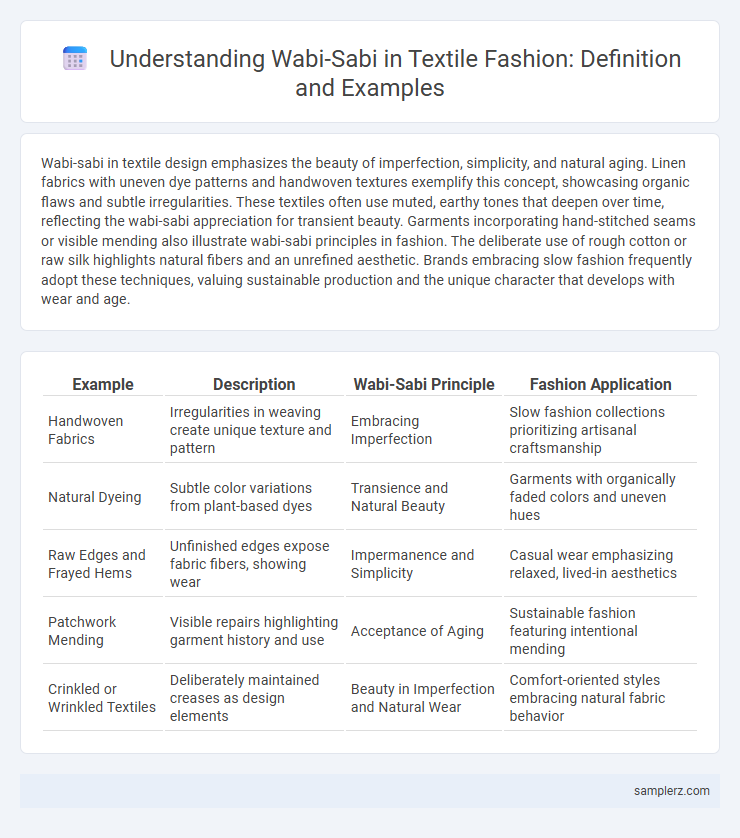Wabi-sabi in textile design emphasizes the beauty of imperfection, simplicity, and natural aging. Linen fabrics with uneven dye patterns and handwoven textures exemplify this concept, showcasing organic flaws and subtle irregularities. These textiles often use muted, earthy tones that deepen over time, reflecting the wabi-sabi appreciation for transient beauty. Garments incorporating hand-stitched seams or visible mending also illustrate wabi-sabi principles in fashion. The deliberate use of rough cotton or raw silk highlights natural fibers and an unrefined aesthetic. Brands embracing slow fashion frequently adopt these techniques, valuing sustainable production and the unique character that develops with wear and age.
Table of Comparison
| Example | Description | Wabi-Sabi Principle | Fashion Application |
|---|---|---|---|
| Handwoven Fabrics | Irregularities in weaving create unique texture and pattern | Embracing Imperfection | Slow fashion collections prioritizing artisanal craftsmanship |
| Natural Dyeing | Subtle color variations from plant-based dyes | Transience and Natural Beauty | Garments with organically faded colors and uneven hues |
| Raw Edges and Frayed Hems | Unfinished edges expose fabric fibers, showing wear | Impermanence and Simplicity | Casual wear emphasizing relaxed, lived-in aesthetics |
| Patchwork Mending | Visible repairs highlighting garment history and use | Acceptance of Aging | Sustainable fashion featuring intentional mending |
| Crinkled or Wrinkled Textiles | Deliberately maintained creases as design elements | Beauty in Imperfection and Natural Wear | Comfort-oriented styles embracing natural fabric behavior |
The Essence of Wabi-Sabi in Textile Design
Wabi-sabi in textile design embraces imperfection, asymmetry, and natural textures, highlighting the beauty of simplicity and transience in fabrics. Techniques such as hand-dyeing, uneven weaving, and raw-edge finishes showcase the organic, imperfect qualities that define wabi-sabi aesthetics. Designers use muted color palettes and natural fibers like linen and hemp to evoke a sense of harmony, subtle elegance, and mindful craftsmanship in their textile creations.
Embracing Imperfection: Handwoven Fabrics
Handwoven fabrics in fashion exemplify wabi-sabi by celebrating irregular textures and asymmetrical patterns that highlight natural imperfections. The use of organic fibers such as linen and hemp enhances the tactile experience, emphasizing authenticity and craftsmanship. This approach creates unique, soulful garments that embody beauty in impermanence and simplicity.
Natural Dyes and Faded Beauty
Wabi-sabi in textile design embraces the imperfect beauty found in natural dyes, where colors subtly fade and shift over time, creating unique, organic patterns that celebrate transience. The use of plant-based dyes like indigo, madder, and cochineal highlights the connection between fabric and nature, allowing each piece to develop distinct variations that reflect aging and wear. This fading beauty not only preserves the authenticity of handmade textiles but also fosters a deeper appreciation for impermanence in fashion craftsmanship.
Visible Mending: The Art of Boro Stitching
Visible mending through Boro stitching exemplifies wabi-sabi in textile by embracing imperfection and highlighting the beauty of wear and repair. This traditional Japanese technique uses layered patches and intricate hand stitches to extend the life of garments while adding unique, textured aesthetics. The purposeful visibility of repairs celebrates transience and authenticity, transforming flaws into artistic expressions valued in sustainable fashion.
Uneven Textures: Slubs and Irregular Weaves
Uneven textures in textiles, such as slubs and irregular weaves, exemplify the wabi-sabi aesthetic by embracing imperfection and natural beauty. These intentional flaws create unique tactile experiences and visual depth, highlighting the artisanal craftsmanship behind each fabric. Designers incorporate these textures to evoke authenticity and subtle elegance, aligning with wabi-sabi's appreciation of transience and imperfection in fashion.
Patina and Aging: Textiles That Tell a Story
Wabi-sabi in textile design embraces patina and aging by celebrating natural wear, faded dyes, and imperfections that develop over time, giving each fabric a unique character. Vintage denim with frayed seams and softened textures exemplifies this aesthetic, highlighting the beauty in the garment's history and use. Handwoven linens and naturally dyed cotton fabrics often showcase subtle color shifts and irregularities that tell a story of craftsmanship and aging.
Minimalist Aesthetics in Wabi-Sabi Textiles
Wabi-sabi in textile design embraces minimalist aesthetics by highlighting natural imperfections, asymmetry, and the beauty of aged fabrics such as handwoven linen and raw silk. This philosophy values understated textures and muted color palettes, often found in Japanese indigo dyeing and traditional kasuri weaving techniques. The result is a fabric that embodies simplicity, authenticity, and the transient nature of beauty, core principles of wabi-sabi in contemporary fashion.
Unfinished Edges and Raw Seams
Wabi-sabi in textile design embraces unfinished edges and raw seams to highlight the beauty of imperfection and natural decay. These elements showcase authenticity and craftsmanship by revealing the making process, often seen in artisanal garments and slow fashion collections. Incorporating raw, unrefined details enhances texture and evokes a sense of organic simplicity aligned with Japanese aesthetics.
Celebrating Asymmetry in Fabric Patterns
Wabi-sabi in textile design embraces the beauty of imperfection through asymmetrical fabric patterns that defy conventional symmetry, creating organic and unique visual interest. Hand-dyed techniques like shibori and ikat highlight irregularities in color distribution, enhancing the fabric's natural charm and authenticity. This celebration of asymmetry reflects a philosophical appreciation for transient and imperfect aesthetics, elevating fashion pieces with distinctive, artisanal character.
Upcycled Materials: The Sustainable Wabi-Sabi Approach
Upcycled textiles embody the wabi-sabi philosophy by embracing imperfection and transience, transforming discarded fabrics into unique, sustainable fashion pieces. This approach highlights the beauty of irregular textures, natural wear, and handcrafted details, promoting eco-consciousness in the fashion industry. Designers utilize vintage materials and repurposed fibers to create garments that celebrate authenticity and environmental responsibility.

example of wabi-sabi in textile Infographic
 samplerz.com
samplerz.com